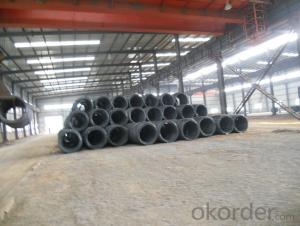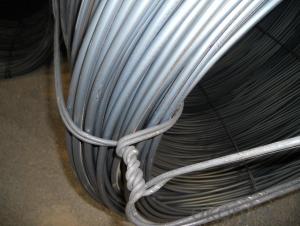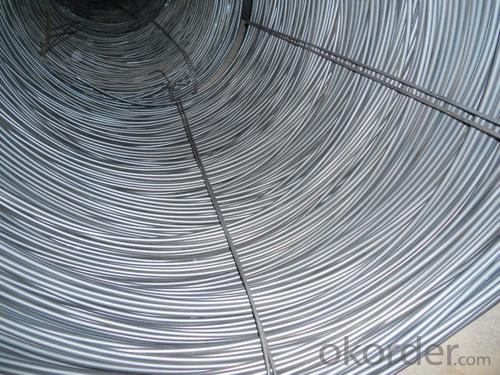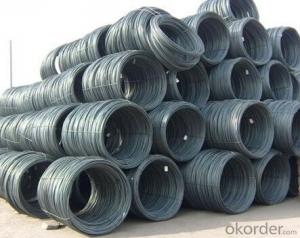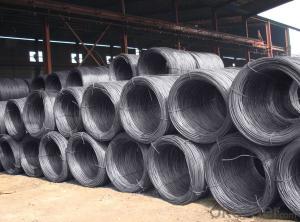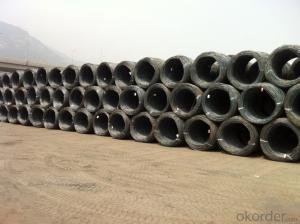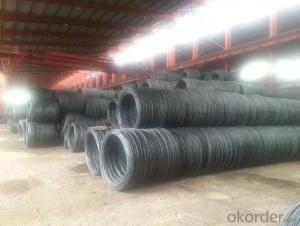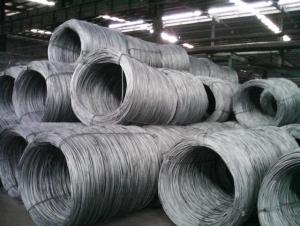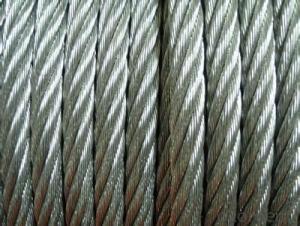ASTM Steel Wire Rods SAE1008,SAE1010, SAE1012
- Loading Port:
- Shanghai
- Payment Terms:
- TT or LC
- Min Order Qty:
- 25 m.t.
- Supply Capability:
- 200000 m.t./month
OKorder Service Pledge
OKorder Financial Service
You Might Also Like
Product Description:
OKorder is offering ASTM Steel Wire Rods SAE1008,SAE1010, SAE1012 at great prices with worldwide shipping. Our supplier is a world-class manufacturer of steel, with our products utilized the world over. OKorder annually supplies products to European, North American and Asian markets. We provide quotations within 24 hours of receiving an inquiry and guarantee competitive prices.
Product Applications:
After hot-rolled the products shaped into coil and delivery as finished product, including round, square,rectangular, hexagonal and so on. Since most of the products are round, it is generally called wire rod. Carbon steel wire rod is widely used in construction and manufacturing. Carbon steel wire rod is mainly used for reinforcement of reinforced concrete and welded structure or reprocessed (roberts , nail, etc.) materials, especially used to produce wire drawing, welding electrode, nails, spring, electronic, precise machinery parts and so on.
Product Advantages:
OKorder's ASTM Steel Wire Rods SAE1008,SAE1010, SAE1012 are durable, strong, and resist corrosion.
Main Product Features:
· Premium quality
· Prompt delivery & seaworthy packing (30 days after receiving deposit)
· Corrosion resistance
· Can be recycled and reused
· Mill test certification
· Professional Service
· Competitive pricing
Product Specifications:
ASTM Steel Wire Rods SAE1008,SAE1010, SAE1012
Grade: SAE1006-SAE1018
Certificates: ISO, SGS, BV, CIQ
Packaging: Export packing, nude packing, in coils
Grade | Chemical Composition (%) | |||||
C | Mn | S | P | Si | B | |
SAE1008B | 0.10max | 0.32max | 0.045max | 0.040max | 0.30max | 0.0008min |
Mechanical properties | ||||||
Yield strength(N/mm2) | Tensile strength(N/mm2) | Elongation (%) | ||||
≥195 | 350-380 | ≥32 | ||||
FAQ:
Q1: Why buy Materials & Equipment from OKorder.com?
A1: All products offered byOKorder.com are carefully selected from China's most reliable manufacturing enterprises. Through its ISO certifications, OKorder.com adheres to the highest standards and a commitment to supply chain safety and customer satisfaction.
Q2: How do we guarantee the quality of our products?
A2: We have established an advanced quality management system which conducts strict quality tests at every step, from raw materials to the final product. At the same time, we provide extensive follow-up service assurances as required.
Q3: The products are invoicing on theoritical weight or on actual weight?
A3: Usually, on actual weight.
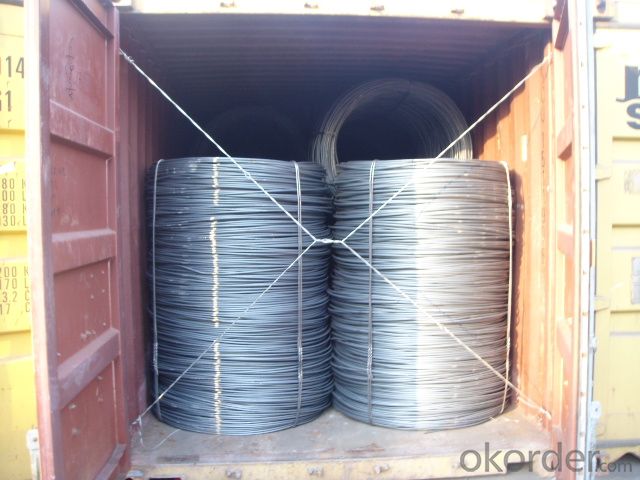
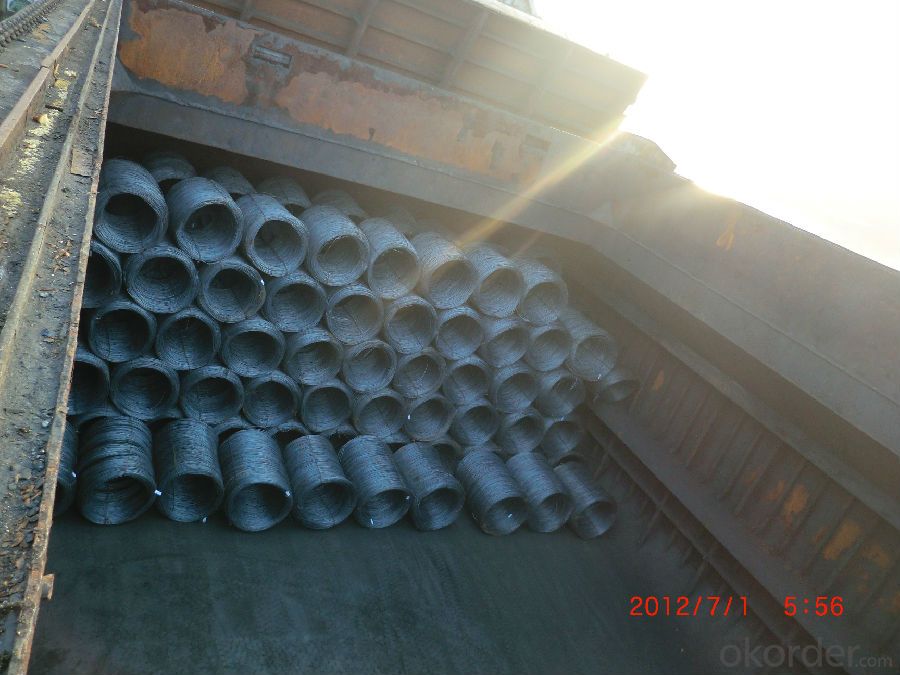
- Q: How does the price of steel wire rod fluctuate in the market?
- The price of steel wire rod fluctuates in the market due to a variety of factors. One significant factor is the supply and demand dynamics within the steel industry. When there is a high demand for steel wire rod, such as during periods of economic growth or construction booms, the price tends to increase. Conversely, when there is a decrease in demand or oversupply of steel wire rod, the price tends to decrease. Another factor that affects the price of steel wire rod is the cost of raw materials. Steel wire rod is typically made from iron ore, which is subject to price fluctuations in the global market. If the cost of iron ore increases, it can lead to higher production costs for steel manufacturers, resulting in higher prices for steel wire rod. Additionally, fluctuations in energy prices can impact the price of steel wire rod. Steel production requires a significant amount of energy, particularly in the form of electricity and natural gas. If energy prices rise, it can increase the cost of production, leading to higher prices for steel wire rod. Furthermore, changes in trade policies and tariffs can also influence the price of steel wire rod. Governments may impose tariffs or trade restrictions on steel imports, which can restrict the supply of steel wire rod in the market and potentially raise prices. Lastly, market speculation and investor sentiment can also contribute to price fluctuations in the steel wire rod market. Investors and traders may anticipate future changes in supply and demand or react to economic indicators, resulting in volatile price movements. Overall, the price of steel wire rod is subject to a range of factors including supply and demand dynamics, raw material costs, energy prices, trade policies, and market speculation. These factors can cause the price to fluctuate in response to changes in the broader economy and industry conditions.
- Q: How is steel wire rod used in the manufacturing of wire for wind turbines?
- Steel wire rod is a crucial component in the manufacturing of wire for wind turbines. The wire rod is first processed through a series of mechanical and chemical treatments to enhance its strength and durability. Once the wire rod has undergone these processes, it is further drawn down to the desired diameter using specialized machinery. The wire rod is then used to produce the various types of wires required for wind turbines. One of the primary applications of steel wire in wind turbines is for the production of guy wires or stay wires. These wires are used to provide stability and support to the wind turbine tower, ensuring it can withstand the strong forces exerted by the wind. Additionally, steel wire rod is also used in the manufacturing of electrical cables and conductors within wind turbines. These cables are responsible for transmitting the generated electrical energy from the turbine to the power grid. The high tensile strength of steel wire ensures that the cables can withstand the mechanical stress and tension associated with wind turbine operation. Furthermore, steel wire is utilized in the production of wire ropes used for hoisting and lifting heavy components during the installation and maintenance of wind turbines. These wire ropes are designed to have excellent tensile strength, corrosion resistance, and flexibility, making them ideal for handling heavy loads in challenging environments. In summary, steel wire rod plays a vital role in the manufacturing of wire for wind turbines. It is used to produce guy wires, electrical cables, and wire ropes, all of which are essential components in the construction, operation, and maintenance of wind turbines. The strength, durability, and flexibility of steel wire make it an ideal material for withstanding the demanding conditions and requirements of wind turbine applications.
- Q: How does the corrosion resistance of steel wire rod vary with different wire drawing processes?
- The corrosion resistance of steel wire rod may vary depending on the specific wire drawing processes utilized. Wire drawing involves pulling the steel wire rod through a series of dies to decrease its diameter and increase its length. One crucial element that impacts corrosion resistance is the surface finish of the wire after the drawing process. Different surface finishes, such as bright, galvanized, or coated, can be achieved through wire drawing processes. These surface finishes act as a barrier between the steel wire rod and the corrosive environment, providing additional protection against corrosion. Another factor that affects corrosion resistance is the reduction in diameter during the wire drawing process. As the diameter decreases, the wire's surface area increases, making it more susceptible to corrosion. However, this can be addressed by selecting appropriate wire drawing processes that ensure a consistent and uniform reduction in diameter, as well as by utilizing corrosion-resistant coatings or treatments. Furthermore, the choice of wire drawing lubricants and cooling methods can impact the corrosion resistance of the steel wire rod. Proper lubrication reduces friction and minimizes surface defects and potential corrosion sites. Effective cooling methods prevent overheating during the drawing process, which can also affect corrosion resistance. To summarize, various factors related to the wire drawing process influence the corrosion resistance of steel wire rod. These factors include the surface finish, reduction in diameter, lubrication, and cooling methods employed. By carefully selecting and optimizing these factors, manufacturers can enhance the corrosion resistance of steel wire rod, ensuring its long-term durability and performance in corrosive environments.
- Q: How is steel wire rod used in the manufacturing of wire forms for bridge cables?
- The manufacturing of wire forms for bridge cables relies heavily on steel wire rod. This essential component serves as the raw material for producing the wire strands that compose the bridge cables. These strands are then twisted together to form the cables, providing the necessary strength and support for bridges. To transform the steel wire rod into suitable wire strands for bridge cables, it undergoes a series of processes. Initially, the rod is cleaned and descaled to eliminate impurities and contaminants. It is then heated to a specific temperature and passed through dies, which decrease its diameter and increase its length. This process, known as wire drawing, takes place. Following wire drawing, the steel wire rod undergoes further processing via a stranding machine. Multiple wire strands are twisted together in a specific pattern to create a stronger and more durable cable. The twisting process ensures that the individual wire strands are tightly bound together, providing the necessary strength to withstand the load and tension experienced by bridge cables. The quality of the steel wire rod used in the manufacturing process is of utmost importance to ensure the strength and performance of the bridge cables. It must possess the appropriate combination of tensile strength, ductility, and corrosion resistance. High-quality steel wire rod meeting specific standards and specifications is carefully chosen to guarantee the reliability and longevity of the bridge cables. In conclusion, steel wire rod plays a critical role in the manufacturing of wire forms for bridge cables. Through processes such as wire drawing and stranding, it is transformed into wire strands, which are then twisted together to form the cables. The quality of the steel wire rod is vital in ensuring the strength and durability of the bridge cables, making it an indispensable component in the construction and maintenance of bridges.
- Q: How is the grain size of steel wire rod measured?
- Metallography, a method commonly employed for measuring the grain size of steel wire rod, involves a series of steps. Initially, a small piece of the rod is cut, and subsequently, it is subjected to grinding and polishing to procure a smooth surface. Once the surface is adequately prepared, a chemical reagent is employed to etch the sample, thereby unveiling the grain boundaries. This etching process facilitates the differentiation of individual grains and enhances their visibility when observed through a microscope. Following the etching process, the sample is meticulously examined under a high magnification microscope. During this examination, the grains are meticulously counted, and their size is determined using either a measuring reticle or specialized software. Consequently, the grain size is typically reported as either an average grain diameter or a grain size number, representing the number of grains within a given area. It is crucial to acknowledge that the measurement of grain size is subject to subjectivity and may vary according to the observer's interpretation. Therefore, standardized methodologies such as ASTM E112 or ISO 643 are commonly employed to ensure uniformity and precision in grain size measurements. These standards offer comprehensive guidelines regarding sample preparation, etching techniques, and grain size determination.
- Q: What are the different types of steel wire rod drawing processes?
- There are several different types of steel wire rod drawing processes used in the manufacturing industry. These processes are designed to transform steel wire rods into various shapes and sizes for different applications. Some of the most common steel wire rod drawing processes include: 1. Cold drawing: This process involves pulling the steel wire rod through a series of dies to reduce its diameter and increase its length. This is done at room temperature, and the wire is often coated with a lubricant to facilitate the drawing process. 2. Annealing: This process involves heating the steel wire rod to a specific temperature and then slowly cooling it to relieve internal stresses and improve its ductility. Annealing is often performed after cold drawing to enhance the wire's mechanical properties. 3. Tempering: This process is used to further improve the mechanical properties of the wire by heating it to a specific temperature and then rapidly cooling it. Tempering helps to increase the wire's strength and toughness. 4. Coating: Steel wire rods can also undergo a coating process to enhance their corrosion resistance or improve their appearance. Common coating methods include galvanizing, where a layer of zinc is applied to the wire's surface, and electroplating, where a thin layer of another metal is deposited onto the wire. 5. Stranding: This process involves combining multiple steel wire rods into a single strand. The individual wires are twisted together to form a stronger and more flexible strand, which is often used in applications such as ropes and cables. 6. Drawing with intermediate annealing: In this process, the steel wire rod is cold drawn several times, with intermediate annealing steps in between. This helps to further reduce the wire's diameter and improve its mechanical properties. Overall, these different types of steel wire rod drawing processes allow manufacturers to produce wires with various properties, sizes, and shapes to meet the specific requirements of different industries and applications.
- Q: What are the different types of steel wire rod coatings used for improved electrical conductivity?
- There are several types of steel wire rod coatings used for improved electrical conductivity, including copper, tin, silver, and nickel. These coatings help enhance the wire's ability to conduct electricity by reducing resistance and improving the flow of electrical current.
- Q: What are the different types of steel wire rod drawing lubricants?
- There are several different types of steel wire rod drawing lubricants that are used in the wire manufacturing industry. These lubricants are essential for reducing friction and heat during the drawing process, ensuring smooth wire production. 1. Oil-based lubricants: These lubricants are made from petroleum-based oils and are commonly used in wire drawing operations. They provide good lubrication and cooling properties, reducing friction and heat generation during the drawing process. 2. Emulsion lubricants: Emulsion lubricants are a mixture of oil and water, which are commonly used as lubricants in wire drawing processes. They offer better cooling properties compared to oil-based lubricants and are suitable for high-speed wire drawing operations. 3. Synthetic lubricants: Synthetic lubricants are made from synthetic oils and provide excellent lubrication properties. They have a high viscosity index, which means they maintain their lubricating properties over a wide range of temperatures. Synthetic lubricants are commonly used in high-speed wire drawing operations. 4. Dry lubricants: Dry lubricants are in the form of powders or solid films that are applied to the wire surface. These lubricants provide excellent lubrication and are suitable for wire drawing operations where liquid lubricants may interfere with subsequent processes, such as plating. 5. Grease lubricants: Grease lubricants are semi-solid lubricants that are commonly used in wire drawing operations. They offer good lubrication properties and can be easily applied to the wire surface. It's important to note that the choice of lubricant depends on various factors, including the wire material, wire diameter, drawing speed, and other specific requirements of the wire drawing process. Therefore, it's essential to consult with lubricant suppliers or industry experts to determine the most suitable lubricant for a particular wire rod drawing operation.
- Q: What are the different types of steel wire rod surface defects and their prevention methods?
- There are several types of steel wire rod surface defects, including scale, cracks, scratches, pits, and slivers. Scale can be prevented by properly controlling the temperature during the production process and using a protective coating. Cracks can be avoided by ensuring proper cooling and reducing stress during the production. Scratches can be prevented by implementing proper handling and storage techniques. Pits can be minimized by using high-quality raw materials and maintaining a clean production environment. Slivers can be prevented by regularly inspecting and maintaining the equipment. Overall, strict quality control measures and adherence to production guidelines are crucial in preventing these surface defects in steel wire rods.
- Q: How is the surface quality of steel wire rod evaluated?
- Various methods and criteria are utilized to assess the surface quality of steel wire rod, ensuring its appropriateness for diverse applications. Among these methods, visual inspection stands as a common approach, wherein trained inspectors visually scrutinize the wire rod's surface for any flaws or irregularities. This encompasses the examination of surface cracks, pits, spots, or any other observable imperfections. In addition to visual inspection, non-destructive testing techniques serve as viable means to evaluate surface quality. One such technique is magnetic particle inspection, which entails the application of a magnetic field to the wire rod, along with the administration of fine iron particles onto the surface. Any surface defects or cracks disrupt the magnetic field, causing the iron particles to accumulate and thus making the flaws discernible. Ultrasonic testing represents an alternative non-destructive method employed to assess the surface quality of steel wire rod. By transmitting high-frequency sound waves into the wire rod, any reflections or alterations in the sound waves indicate the presence of defects or irregularities on the surface. Furthermore, the surface quality can be gauged through the measurement of specific physical properties of the wire rod. For instance, the roughness of the surface can be quantified using instruments such as a profilometer, which provides a numerical value denoting the smoothness or roughness of the surface. This becomes significant, as certain applications necessitate a specific level of surface roughness to optimize performance. In essence, the evaluation of the surface quality of steel wire rod encompasses a combination of visual inspection, non-destructive testing techniques, and physical property measurements. By employing these evaluation methods, manufacturers ensure that the wire rod adheres to the required standards and is suitable for its intended purpose.
Send your message to us
ASTM Steel Wire Rods SAE1008,SAE1010, SAE1012
- Loading Port:
- Shanghai
- Payment Terms:
- TT or LC
- Min Order Qty:
- 25 m.t.
- Supply Capability:
- 200000 m.t./month
OKorder Service Pledge
OKorder Financial Service
Similar products
Hot products
Hot Searches
Related keywords

